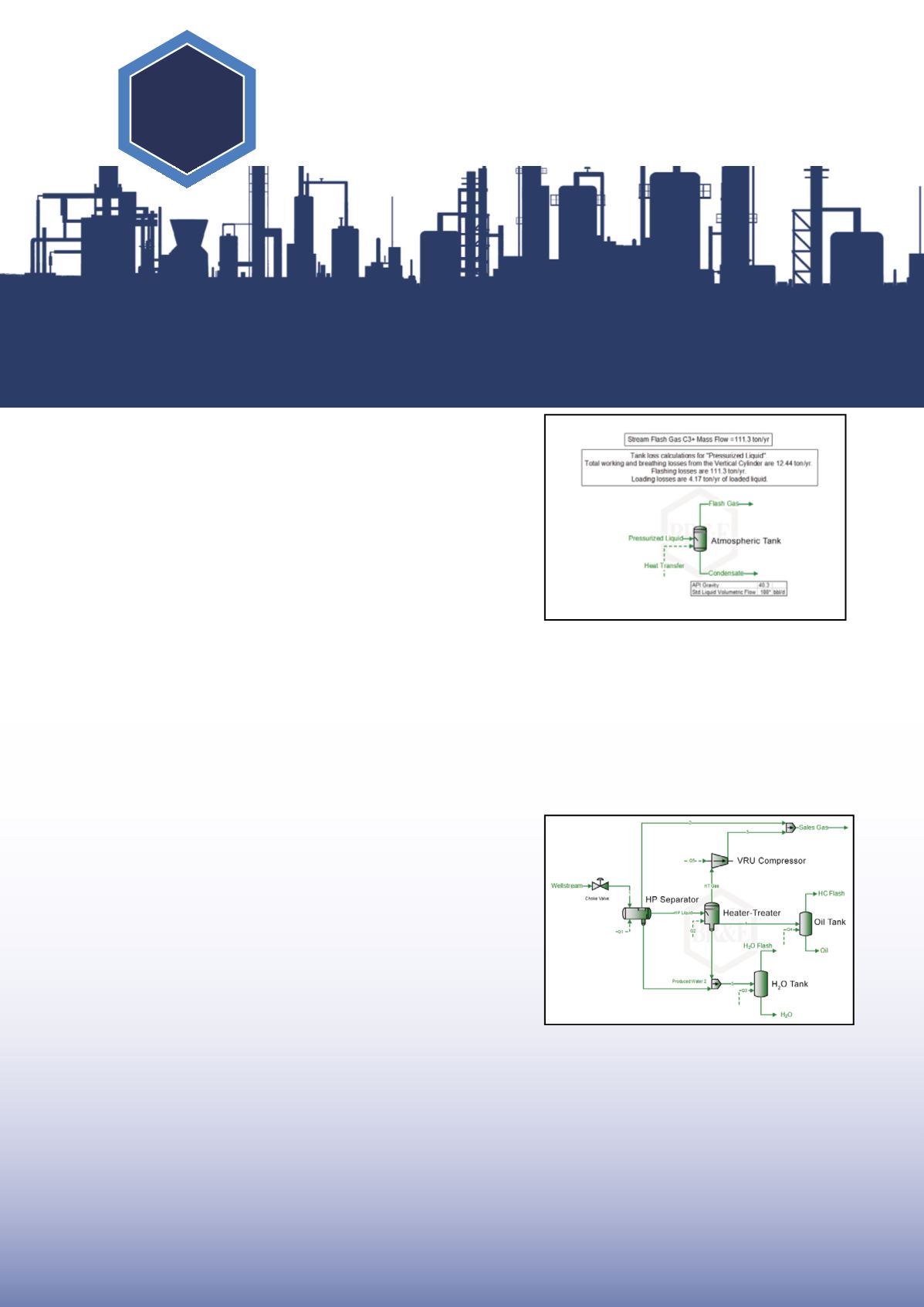
BR
&
E
ProMax
Process Simulation Software
Process Insight
:
Air Emissions Modeling Advances for
Oil and Gas Production Facilities
®
A
perfect storm
has dramatically changed the way oil
and gas production facilities are designed and permitted for air
quality compliance.
Air quality regulations have been strengthened due to
rule changes in the Clean Air Act (40 CFR 60, Subpart OOOO),
drastically reducing the allowed emissions of VOCs from well
sites. These changes were made along with new regulations
of Green House Gas emissions (40 CFR 98, Subpart W). Due
to the more stringent and complex permitting regime, it is now
important to accurately predict VOC emissions rates from oil
and condensate tanks. More complex well site designs which
RIWHQ LQFOXGH ÀDUHV YDSRU UHFRYHU\ WRZHUV DQG YDSRU UHFRYHU\
compressors are now commonplace. This calls for design-class
process simulation tools.
Along with more stringent rules, the shale revolution
has caused the number of wells drilled in the US to sky-rocket.
Each of these new wells requires a permit with emissions
estimates, dramatically increasing the work load for compliance.
Along with the calculation requirements for permits, annual
inventory reports are also required for a variety of emissions
sources and contaminants. Examples include Greenhouse Gas
Emissions, Flashing Losses, as well as Working, Breathing, and
/RDGLQJ /RVVHV IURP VWRUDJH WDQNV 1HZ DQG ÀH[LEOH VLPXODWLRQ
programs are therefore necessary to keep up with changes to
calculation requirements.
Well Site Air Emissions – a Brief History
Until recently, well head or compressor station
VHSDUDWRUV DW VLJQL¿FDQW SUHVVXUH SURGXFHG D JDV SURGXFW
WKDW ÀRZHG WR D VDOHV JDV OLQH DQG D OLTXLG SURGXFW WKDW ZDV
ÀDVKHG WR DQ DWPRVSKHULF SUHVVXUH WDQN 7KH 92& ULFK JDVHV
WKDW HYROYHG IURP ÀDVKLQJ GRZQ WR DWPRVSKHULF SUHVVXUH ZHUH
typically vented to the atmosphere. (See Figure 1)
With the new regulations, a comparable well is now
equipped with additional features designed to mitigate,
recover, or convert VOC’s in gases that were previously
vented. Designs similar to Figure 2, in conjunction with a
ÀDUH RU RWKHU FRQWURO GHYLFH DUH FDSDEOH RI QHDU ]HUR 92&
emissions. To achieve such designs, a high-quality process
simulator like ProMax is necessary for evaluating and
RSWLPL]LQJ WKH YDULRXV VFKHPHV
Another result of this more rigorous air permitting
environment is closer coordination between well site
facility design, air permitting, and air quality compliance
personnel. Air quality parameters are considered in
early design phases and now typically drive the design
process. The resulting process simulation is then used by
air permitting and compliance functions throughout the
life of the well. Use of a design-class process simulation
tool helps bring the work of these two groups together in
seamless fashion.
ProMax brings these new and necessary capabilities
to the design, permitting, and compliance teams.
Additionally, an EPAAP-42 Working, Breathing, and
Loading Loss calculation tool has been added to ProMax so
WKDW DOO FDOFXODWLRQV FDQ EH SHUIRUPHG LQ D VLQJOH PRGHO ¿OH
ProMax enables compliance teams to run hundreds- even
thousands- of well site inventory calculations in a fraction
of the time and with greater accuracy than was ever possible
before!
For more information about this study, see the full article at
www.bre.com/support/technicalarticlesProMax® process simulation software by Bryan Research & Engineering, LLC
Engineering Solutions for the Oil, Gas, Refining & Chemical Industries








